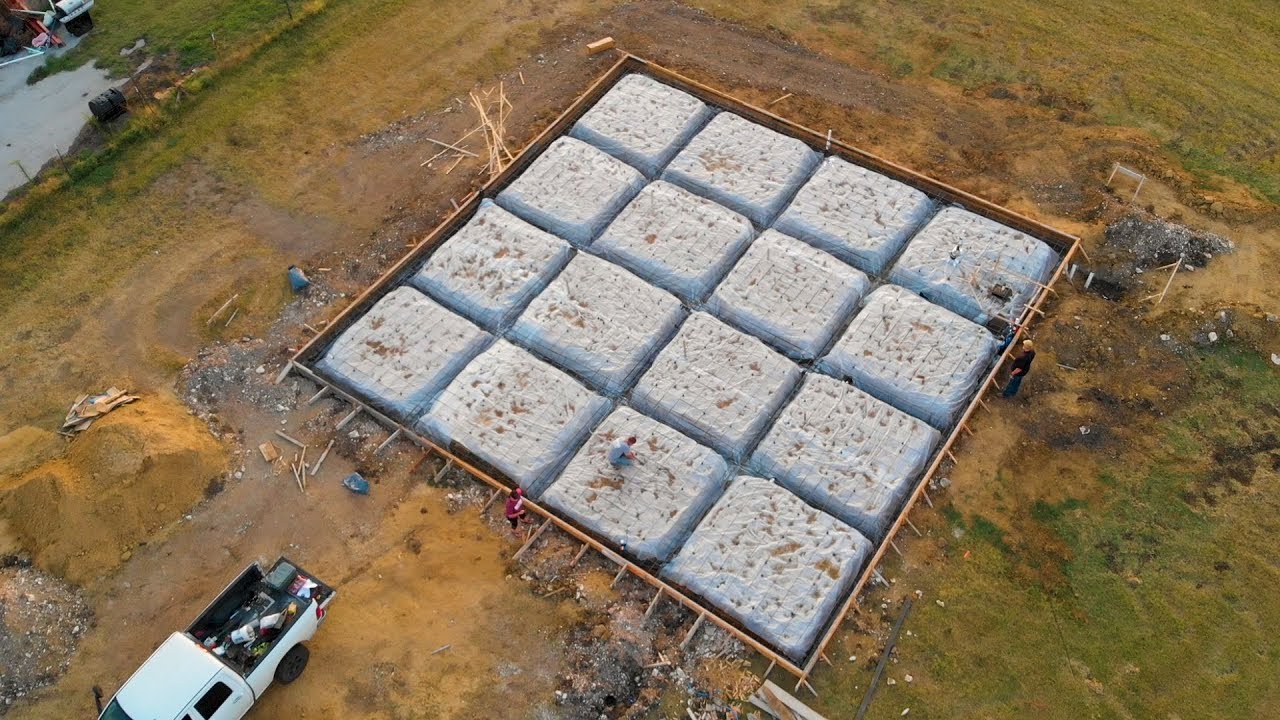Building a barndominium has become a popular trend in recent years. These versatile structures offer the perfect combination of a barn and a home, providing ample living space and storage. However, before you can start decorating your new space, you need to know how to pour a slab for your barndominium.
Pouring a slab is an essential step in the construction process, and it requires careful planning and execution. In this article, we will take a look at the steps involved in pouring a slab for a barndominium and offer some tips to ensure that your project is a success. So, let’s get started!
To pour a slab for a barndominium, you need to follow these steps:
- Prepare the site by clearing the area and leveling the ground.
- Set up the formwork to create the shape of the slab.
- Install reinforcement bars or mesh to provide added strength to the slab.
- Pour the concrete mixture into the formwork and use a screed board to level the surface.
- Allow the concrete to cure for at least 28 days before installing any fixtures or finishing the surface.

How to Pour a Slab for a Barndominium: A Comprehensive Guide
1. Site Preparation
Before pouring the slab for your barndominium, it’s crucial to prepare the site properly. Start by clearing the area of any debris, rocks, or vegetation that could hinder the pouring process. Next, level the ground and ensure that the soil is properly compacted to prevent any settling or shifting after the slab is poured.
It’s also important to consider the site’s drainage. Ensure that the site slopes away from the barndominium to prevent water from pooling around the foundation. You may need to install a drainage system or a French drain to divert water away from the building.
2. Building Permits and Codes
Before beginning any construction work, you’ll need to obtain the necessary building permits and ensure that your project complies with local building codes. Failure to do so could result in costly fines and delays in your construction timeline.
Consult with your local building department to determine the specific requirements for your area. You may need to submit plans and undergo inspections throughout the construction process.
3. Formwork and Reinforcement
Once the site is prepared, you’ll need to create formwork to hold the concrete in place as it sets. Formwork can be made from wood, metal, or plastic, and should be designed to match the shape and dimensions of your barndominium’s foundation.
Reinforcement is also essential for a sturdy and durable foundation. Steel rebar or mesh can be used to reinforce the slab and prevent cracking or shifting over time. Be sure to follow the recommended spacing and placement guidelines to ensure proper reinforcement.
4. Concrete Mix and Pouring
The quality of the concrete mix is critical to the success of your foundation. Consult with a professional concrete supplier to determine the appropriate mix for your project and the climate in your area.
When pouring the concrete, be sure to work quickly and efficiently to prevent the mix from drying out or setting too quickly. Use a concrete pump or mixer to ensure a consistent mix and avoid any lumps or air pockets.
5. Finishing and Curing
After the concrete is poured, it’s time to finish the surface. This may involve using a trowel or float to smooth out any bumps or imperfections in the surface. You may also choose to add a decorative finish, such as staining or stamping, to enhance the appearance of your foundation.
Finally, the concrete must be allowed to cure properly before any further construction can take place. This process can take several days or even weeks, depending on the climate and the thickness of the slab. Be sure to follow the recommended curing guidelines to ensure a strong and durable foundation.
6. Benefits of a Concrete Slab Foundation
- Increased durability and stability
- Resistance to moisture and pests
- Lower maintenance requirements
- Improved energy efficiency
- Longer lifespan compared to other foundation types
7. Concrete Slab vs. Other Foundation Types
| Concrete Slab | Crawl Space | Basement | |
|---|---|---|---|
| Cost | Lowest | Moderate | Highest |
| Maintenance | Lowest | Moderate | Highest |
| Energy Efficiency | High | Low | Low |
| Space | Lowest | Moderate | Highest |
8. Common Mistakes to Avoid
Some common mistakes to avoid when pouring a concrete slab for your barndominium include:
- Poor site preparation
- Inadequate reinforcement
- Improper concrete mix or pouring technique
- Failure to follow curing guidelines
- Non-compliance with building codes and regulations
9. Hiring a Professional
If you’re not confident in your ability to pour a concrete slab yourself, it’s always best to hire a professional. A qualified contractor will have the experience, equipment, and knowledge necessary to ensure a successful and long-lasting foundation.
Be sure to research potential contractors thoroughly and obtain several quotes before making a final decision. Look for contractors with a proven track record of quality work and satisfied clients.
10. Conclusion
Pouring a concrete slab for your barndominium is a crucial step in the construction process. With proper preparation, reinforcement, and pouring technique, you can ensure a strong and durable foundation that will last for years to come.
By following the guidelines outlined in this article, you can avoid common mistakes and make informed decisions about your foundation type and construction process. Whether you choose to tackle the project yourself or hire a professional, a solid foundation is the key to a successful barndominium construction project.
Frequently Asked Questions
Building a barndominium is a popular trend nowadays, and the first step to build one is to pour a slab. Here are some frequently asked questions about how to pour a slab for a barndominium:
What materials do I need to pour a slab for a barndominium?
Before pouring the slab, you need to prepare the following materials:
– Concrete mix
– Rebar
– Gravel or crushed rock
– Forms
– Screed board
– Bull float
You can purchase these materials at any hardware store or building supply store.
How thick should the slab be for a barndominium?
The thickness of the slab for a barndominium depends on the size of the building and the soil condition. Generally, a slab for a barndominium should be at least 4 inches thick. However, if the soil condition is poor or if you plan to park heavy equipment on the slab, you may need to pour a thicker slab.
It is always better to consult a professional engineer or a contractor to determine the appropriate thickness of the slab for your barndominium.
What is the process of pouring a slab for a barndominium?
The process of pouring a slab for a barndominium involves the following steps:
1. Prepare the site by clearing the area, leveling the ground, and installing forms.
2. Install rebar to reinforce the slab.
3. Pour the gravel or crushed rock as a base for the slab.
4. Mix the concrete and pour it into the forms.
5. Use a screed board to level the concrete and remove excess concrete.
6. Use a bull float to smooth the surface of the concrete.
7. Allow the concrete to cure for at least a week before starting to build on it.
Do I need a permit to pour a slab for a barndominium?
Yes, you need a permit to pour a slab for a barndominium. The permit requirements may vary depending on your location and the size of the building. You can contact your local building department to obtain the necessary permits and to ensure that your slab meets local building codes.
It is important to obtain the necessary permits to avoid any legal issues and to ensure that your barndominium is safe and structurally sound.
Can I pour a slab for a barndominium myself or should I hire a professional?
You can pour a slab for a barndominium yourself if you have experience in concrete work and if you follow the proper procedures. However, if you are not experienced or if you are unsure of what you are doing, it is better to hire a professional to pour the slab.
A professional contractor can ensure that the slab is poured correctly and can handle any issues that may arise during the process. Hiring a professional may cost more, but it can save you time, money, and headaches in the long run.
In conclusion, pouring a slab for a barndominium requires careful planning and execution. The first step is to determine the size and thickness of the slab needed, based on the size of the structure and the soil conditions. Once the site is prepared, the base material should be compacted and leveled to ensure a strong foundation.
Next, the concrete mix should be carefully prepared and poured in sections, with reinforcing mesh or rebar added for extra strength. It is important to keep the concrete moist during the curing process to prevent cracking and ensure a strong, durable slab.
In summary, pouring a slab for a barndominium can be a challenging but rewarding process. By following these steps and working with experienced professionals, you can ensure that your barndominium has a strong foundation that will last for decades to come.
